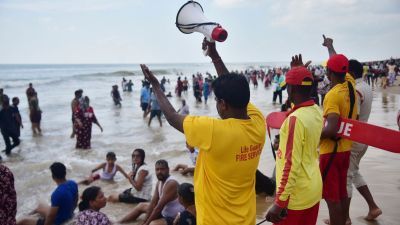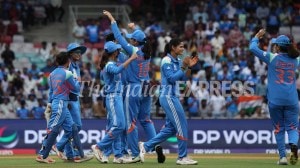New tribe of women mark a `watershed’ in gender ties
GAURAIYA (SAGAR), MARCH 27: ``Chupay rahau. Tumain jaoo naeen malum ki check dam pani bharibe ke lae naeen pani zameen man risaibe ke lae...

GAURAIYA (SAGAR), MARCH 27: “Chupay rahau. Tumain jaoo naeen malum ki check dam pani bharibe ke lae naeen pani zameen man risaibe ke lae hot hai!” (Shut up. You don’t even know that a check dam is not for storing water but for ensuring that it seeps into the ground.)
When Sita Bai, the semi-literate chairperson of the all-women Watershed Management Committee of Gauraiya village speaks, the village’s garrulous sarpanch Prem Narain Chaube listens. Her rebuke mirrors a new village reality: Women in Bundelkhand’s feudal society are ready to discard their veil and take on domineering men when it comes to community issues.“Three years back, not even a blade of grass grew on Gairaiya-Bhilaya Bhataar (barrens),” says Sita Bai, pointing toward lush green fields and hillocks,“Parents dreaded marrying their daughters off to lads from a village that had no source of water miles around.”
Today, each of the 110 households in Gauraiya, a multi-caste village 25 km from Sagar district headquarters on the nationalhighway to Bhopal, gets assured water supply through pipes. The wells and ponds which dried up within months of the rains, are now full of water.
Within two years of the project launched by the Rajiv Gandhi Watershed Management Mission, the area under cultivation has almost doubled and the average farm produce trebled. At least 55 households in Gauraiya have TV sets.
“No doubt things have changed for the better. But I am not sure if this prosperity will last after two years, when the project officials leave,” says sarpanch Chaube, continuing to play the role of a Doubting Thomas.But newly-emerged community leaders like Sita Bai, Rajkumari, Malati and Siyarani — who head all-women watershed management committees in Goraiya, Bhilaiya, Samnapur and Nittari villages respectively — are undaunted.“There is no going back,” asserts Sita Bai. Emboldened by their success, women’s self-help groups now zealously protect the 5.5 lakh trees planted in the community and government land. Those whose cattle strayinto the protected area and damage the plantation are fined. “Social fencing by women volunteers has ensured that 90 per cent of the planted trees have survived,” says Watershed Project Officer Alok Jain. The improvement in soil quality and underground water levels has also led to regeneration of nearly three lakh teak and two lakh bamboo trees planted by the Madhya Pradesh Forest Department four years ago.
Gauraiya women have also organised seven mahila bachat samoohs (women’s self-help groups) with bank savings ranging from Rs 15,000 to Rs 25,000. They are now keen on exploring new avenues to augment their incomes.Some of these groups have taken up a Government contract to supply porridge and dal to 150 anganwadis in adjoining villages under a Central Government-sponsored mid-day milk scheme. Others like Jagriti, a self-help group of Harijan women, plan to go in for cattle rearing.
The success of these women’s groups has forced Gauraiya’s men to follow. They have started two savings groups. As SagarCollector Prabhanshu Kamal puts it, “In Gauraiya, women lead and men follow.”
Other watershed management schemes launched by the RG Mission to cover 34 lakh hectares of degraded land in over 8,000 MP villages, have also been successful. Yet, it is the change in gender relations brought about by the empowerment of women in managing the village’s resources, like land and water, that makes the story of Gauraiya stand apart.
The decision to have all-women watershed management committees in the area was prompted by the fact that though women in Bundelkhand’s feudal society remain behind the veil, the task of fetching drinking water from far flung places falls on them. A Bundeli colloquialism, `Gagari na phoote chahen khasam mari jay'(Don’t let the earthen water-pitcher on your heads fall even if your husband dies), exemplifies this.
The experiment has paid unexpected dividends.“Few of us could read and write when we were inducted into the watershed management committees in 1997. Today, every women memberof the committee operates her own bank account and keeps a record of the income and expenditure of the group she leads,” informs Sita Bai.
The enlightened women leaders soon started a literacy drive in the four villages and today, no woman has to affix her thumb impression. The women’s groups also make sure that no girl of school-going age drops out of the village school.
The new awareness has made these women more assertive and they have been able to imposed total prohibition in their villages. “I myself used to drink heavily,” admits Mohana Bai, a tribal from Bhilaiya, “But now, I don’t allow even my husband to touch the bottle.”
Men who tried to defy the women’s diktat got it hard; women mobbed and publicly humiliated those who returned home drunk, even making them pay hefty fines.
“Now we respect our women and listen to what they tell us. Have they not brought a new awakening and well-being in these desolate barrens!”says Nanhakoo Ram, Samnapur’s ex-sarpanch, whose grudging compliment is aneloquent testimony to the new women power in Gauraiya, Bhilaiya, Samnapur and neighbouring villages.






- 01
- 02
- 03
- 04
- 05

























